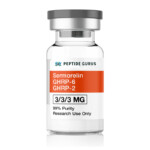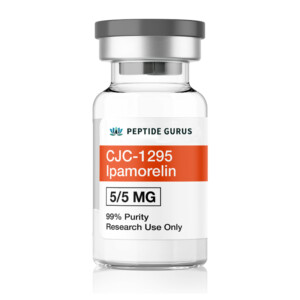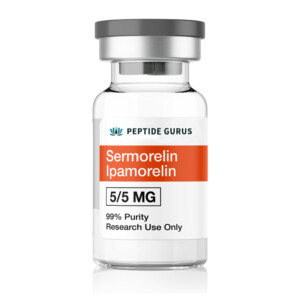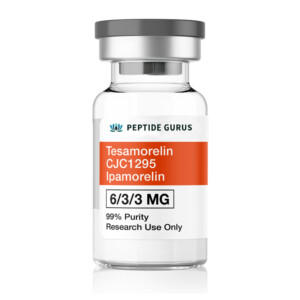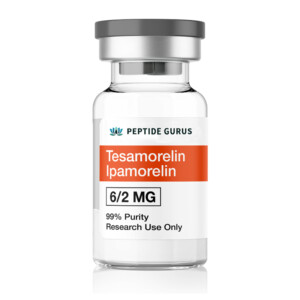sermorelina,GHRP-6,GHRP-2
A combination of growth hormone (GH) releasing peptides can lead to tremendousincreases in GH levels, but such a process generally only requires a growth hormonereleasing hormone (GHRH) analogue like sermorelin and a growth hormone secretagogue/ghrelin analogue like GHRP-2 or GHRP-6. Combining all three isn’t likely tocause a proportionally greater increase in GH hormone levels, but are other reasons toutilize such a combination.
Sermorelin is an excellent GHRH analogue with strong GH releasing action and very fewoff-target effects. in addition., the peptide has been found in animal studies to improveheart health, aumentar la densidad ósea, mejorar la función renal, and possibly even fight off theeffects of dementia. GHRP-2 not only helps to build muscle, but has been shown toenhance muscle structure as well[1]-[3]. lt is also a strong appetite stimulant, improvesheart function, boosts immune function, reduces pain perception, and benefits sleepquality[4]-[10]. GHRP-6 has been shown to protect brain tissue, enhance memory, boostwound repair, and modulate reward-seeking behavior[11]-[21].
The above list of effects demonstrates both common overlap as well as complimentary features for the peptides above. By combining a GHRH analogue and a ghrelin analogue.maximal growth hormone release is achieved. By combining all three peptides in thecorrect way (p.ej. alternating GHRP-6 with GHRP-2 dosing), it is possible to also amplifythe peptides’ secondary effects and achieve additional benefits such as enhanced bonedeposition, improved brain protection, y más.
Autor del artículo
La literatura anterior fue investigada, editado y organizado por el Dr.. logan, MARYLAND. Dr. Loganholds a doctorate degree from Case Western Reserve University School of Medicine anda B.S. en biología molecular.
Scientific Journa Author
Richard F.. Caminante, Doctor, R.Ph, lead author of A better approach to management of adult-.onset growth hormone insufficiency?”, recibió una licenciatura en farmacia de la Universidad de Rutgers, una maestría en Bioquímica de la Universidad Estatal de Nuevo México y un doctorado en afisiología de la Universidad de Rutgers. Tiene becas postdoctorales en neuroendocrinología y neurofarmacología en la Facultad de Medicina de la Universidad de Duke.(Centro para el Estudio del Envejecimiento y el Desarrollo Humano) y la Universidad de California, berkeley, respectivamente.
Richard F.. Caminante, Doctor, Se hace referencia a R.Ph como uno de los principales científicos involucrados en la investigación y el desarrollo de Sermorelin.. De ninguna manera este médico/científico respalda o recomienda la compra, venta, o uso de este producto por cualquier motivo. No hay afiliación o relación., implícito o no, entre PEPTIDE GURUS y este doctor. El propósito de citar al médico es reconocer, reconocer, y damos crédito a los exhaustivos esfuerzos de investigación y desarrollo realizados por los científicos que estudian este péptido.. Richard F.. Caminante, Doctor, R.Ph figura en [22 ]bajo las citas referenciadas.
Recursos
1.R. Hu et al., “Effects of GHRP-2 and Cysteamine Administration on GrowthPerformance, Deposición de hormonas del eje somatotrópico y proteínas musculares en yaks(Bos grunniens) con retraso del crecimiento,” PloS One, volumen. 11, no.2, p.e01494612016.
2.D. Yamamoto et al., "GHRP-2, un agonista del GHS-R, directly acts on myocytes toattenuate the dexamethasone-induced expressions of muscle-specific ubiquitinligases, Atrogin-1 and MuRF1,” Life Sci., vol.82,no.9-10, pp.460-466, Feb2008.[PubMed]
3.L.T. Phung et al., “Los efectos del péptido 2 liberador de la hormona del crecimiento (GHRP-2)sobre la liberación de la hormona del crecimiento y el rendimiento del crecimiento en cerdos,” Domest.Anim.Endocrinol., vol.18, no.3, pp.279-291,Apr.2000.[PubMed]
4.B.Laferrère,C.Abraham,C.D.Russell, and C.Y.Bowers, “Growth hormonereleasing peptide-2 (GHRP-2), como grelina, aumenta la ingesta de alimentos en hombres sanos,J.Clin.Endocrinol. Metab., vol.90, no.2, pp.611-614, Feb.2005.[PubMed]
5.B. Laferrere,A. B. Ciervo, and C.Y. Bowers, “Obese subjects respond to thestimulatory effect of the ghrelin agonist growth hormone-releasing peptide-2 onfood intake,”obesos. Silver Spring MD, vol.14,no.6,pp.1056-1063, Jun.2006[PMC]
6.GRAMO. Muccioli et al., “Growth hormone-releasing peptides and the cardiovascularsystem,”Ann.Endocrinol., vol.61,no.1, pp.27-31, Feb.2000.[PubMed]
7.V. Bodart et al., “ldentification and characterization of a new growth hormonereleasing peptide receptor in the heart,” Circ.Res., vol.85,no.9, pp.796-802Oct.1999.[PubMed]
8.D. D. taub, W.. j. murphy, and D.L. largo, “Rejuvenecimiento del timo envejecido:Vías de señalización mediadas por la hormona del crecimiento y mediadas por la grelina.,”. Opin.Pharmacol.,vol.10,no.4,pp.408-424,Aug.2010.[PubMed]
9.GRAMO. Copinschi et al., “Tratamiento oral prolongado con MK-677, a novel growthhormone secretagogue, mejora la calidad del sueño en el hombre,” Neuroendocrinology, vol.66,no.4, pp.278-286, Oct. 1997.[PubMed]
10.PAG. Zeng et al., “Agonista del receptor de grelina, GHRP-2, produces antinociceptive effectsat the supraspinal level via the opioid receptor in mice,” Péptidos, volumen. 55, páginas. 103-109, Puede 2014.[PubMed]
11.C.-C. Huang, D. Chou, C.-M. Yeh, and K.-S. Hsu,“Acute food deprivation enhances fear extinction but inhibits long-term depression in the lateral amygdalavia ghrelin signaling,”Neuropharmacology, vol.101, pp.36-45, Feb.2016.[PubMed]
12.S. Beheshti and S. Shahrokhi, “Blocking the ghrelin receptor type 1a in the ratbrain impairs memory encoding,”Neuropeptides, vol.52,pp.97-102, Aug.2015.
13.k. Tóth, k. László, y l. Lénárd, “Role of intraamygdaloid acylated-ghrelin in3spatial learning,” Brain Res. Bull., volumen. 81,no.1, pp.33-37, Jan.2010.[PubMed]
14.N.Subirós et al.. “Assessment of dose-effect and therapeutic time window inpreclinical studies of rhEGF and GHRP-6 coadministration for stroke therapy,Neurol.Res., vol.38, no.3, pp.187-195, Mar.2016.[PubMed]
15.S. j. Spencer, A. A. Molinero, y Z. B. Andrews, “The Role of Ghrelin inNeuroprotection after lschemic Brain Injury,” Brain Sci., volumen. 3, No. 1, páginas. 344-359Mar.2013.[PMC]
16.Y. Suda et al., “Down-regulation of ghrelin receptors on dopaminergic neurons inthe substantia nigra contributes to Parkinson’s disease-like motor dysfunction,Mol. Brain, vol.11,no.1,p.6,20 2018.[BMC]
17.Y. Mendoza Marí et al., “Growth Hormone-Releasing Peptide 6 Enhances theHealing Process and lmproves the Esthetic Outcome of the Wounds,” PlasticSurgery International, 2016.[En línea]. Disponible:https://www.hindawi.com/journals/psi2016/4361702/.[Accedido: 23-mayo-2019][PMC]
18.METRO. FernÃández-Mayola et al., “Growth hormone-releasing peptide 6 preventscutaneous hypertrophic scarring: early mechanistic data from a proteome study,En t. Wound J., vol.15,no.4, pp.538-546,Aug.2018.[PubMed]
19.j. Berlanga et al., “Growth-hormone-releasing peptide 6 (GHRP6) prevents oxidantcytotoxicity and reduces myocardial necrosis in a model of acute myocardialinfarction,”Clin.Sci.Lond.Engl.1979,vol.112,no.4,pp.241-250,Feb.2007[PubMed]
20.l. Hyland et al., “Central ghrelin receptor stimulation modulates sex motivation inmale rats in a site dependent manner,” Horm. Comportamiento., volumen. 97, pp.56-66, 2018[Ciencia directa]
21.H.-J. Huang et al., “The protective effects of Ghrelin/GHSR on hippocampalneurogenesis in CUMS mice,” Neuropharmacology, Puede 2019. [PubMed]
22.R. F. Caminante, “Sermorelín: Un mejor enfoque para el tratamiento de la insuficiencia de la hormona del crecimiento que aparece en la edad adulta?,”Clin.Interv.Envejecimiento, volumen. 1, no.4, págs.307-308, Dic. 2006.[PubMed]
TODOS LOS ARTÍCULOS Y LA INFORMACIÓN DE PRODUCTOS PROPORCIONADOS EN ESTE SITIO WEB SON SÓLO PARA FINES INFORMATIVOS Y EDUCATIVOS.
Los productos ofrecidos en este sitio web se proporcionan únicamente para estudios in vitro.. estudios in vitro(latín: en cristal) se realizan fuera del cuerpo. Estos productos no son medicamentos ni drogas y no han sido aprobados por la FDA para prevenir, tratar o curar cualquier condición médica, dolencia o enfermedad. La introducción corporal de cualquier tipo en personas o animales está estrictamente prohibida por la ley..



